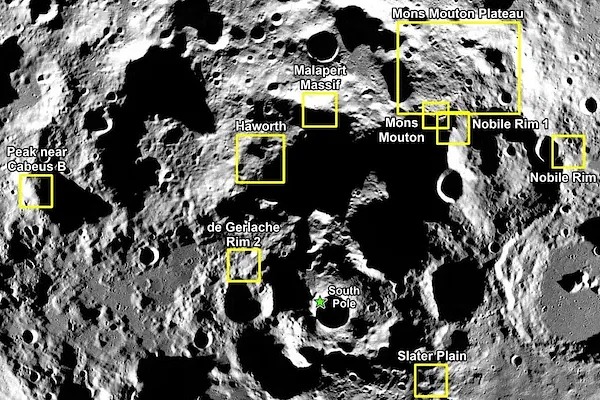NASA prepares for Artemis III's historic lunar landing, selecting nine key sites at the Moon's south pole for groundbreaking exploration and resource studies.
 |
| NASA's Artemis III mission aims to land astronauts near the Moon's south pole, targeting nine promising sites for unprecedented exploration and scientific discovery. Image: Collected |
Washington, DC, USA - November 4, 2024:
NASA’s Artemis III mission, part of its broader Artemis program, is set to mark humanity’s return to the Moon, aiming to land astronauts on lunar terrain for the first time in over five decades. This mission, which builds upon the knowledge gained from previous Apollo missions, will explore nine potential landing sites, all near the Moon's south pole. These include regions like Mons Mouton, Nobile Rim, and Slater Plain, which have been meticulously chosen based on scientific and engineering criteria.
What makes these sites particularly valuable is their unique environment, largely unexplored due to the extreme and permanent darkness that engulfs parts of the south pole. This region is considered a treasure trove for scientists, as it likely contains ancient, well-preserved lunar terrain that may hold water ice in its permanently shadowed craters. This water could provide not only crucial resources for sustained lunar exploration but also insights into the broader history of the Moon and solar system. NASA scientists, including Sarah Noble and Lakisha Hawkins, emphasize that exploring these shadowed regions could reveal valuable compounds trapped in the lunar soil, potentially even informing future Mars missions.
The Artemis III landing will therefore be significant on two fronts: scientifically, by exploring regions untouched by Apollo astronauts, and technologically, as NASA continues to advance its lunar landing and life-support systems. Unlike the Apollo missions, which mainly targeted regions near the Moon's equator, Artemis III’s exploration of the south pole will require enhanced technologies to navigate and work within the Moon’s extreme conditions. This return to lunar exploration could set the stage for a sustained human presence on the Moon, aiming to leverage its resources to enable future deep-space exploration.
Ultimately, Artemis III represents both a bridge to the Moon's uncharted territories and a stepping-stone to humanity's next frontier beyond Earth, with the Moon's south pole at the center of NASA’s plans to build sustainable off-world capabilities.